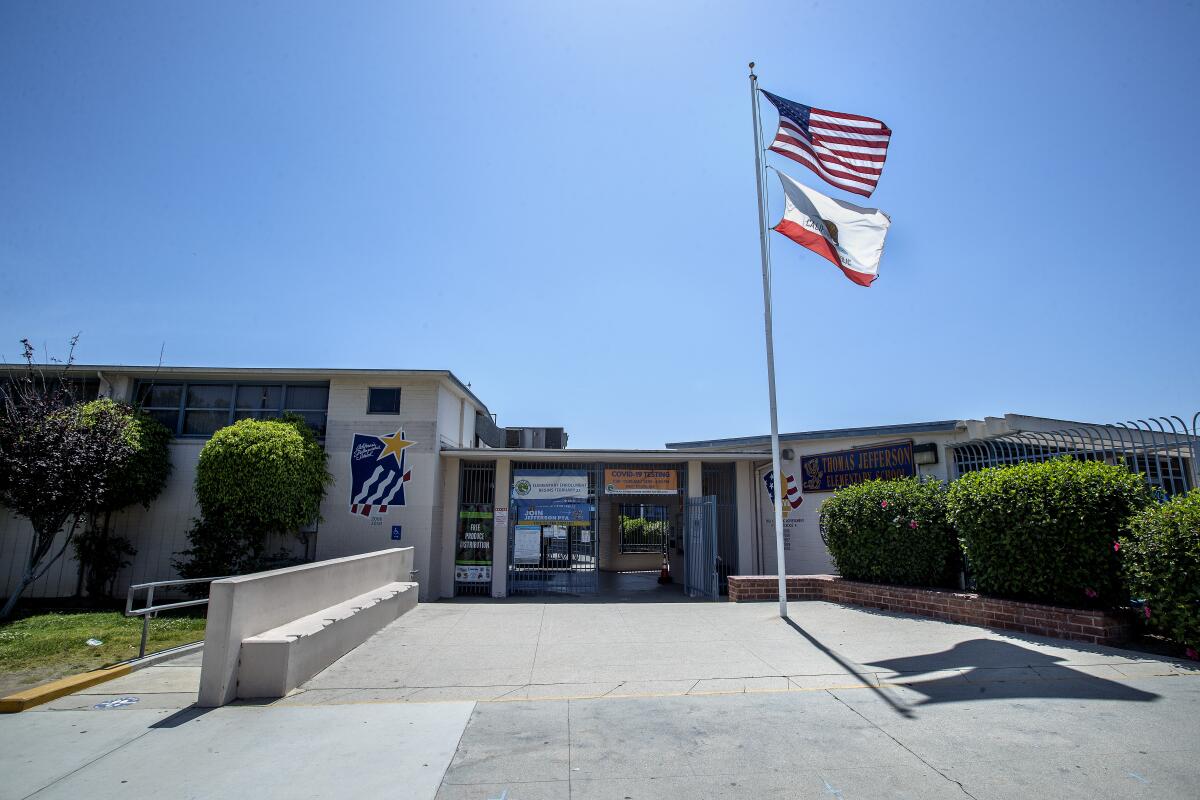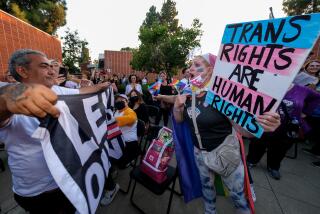What California law requires in teaching about LGBTQ people in public schools

Gay pride videos shown in a Glendale third-grade classroom have added an intense local chapter to a national debate over how and when lessons on gender identity and sexual orientation should be broached in public schools.
The episode unfolded with the disclosure that a teacher at Jefferson Elementary had shown her students gay pride videos and had asked for the district’s help in assessing which of four specific videos would be appropriate for classroom use. The teacher’s lessons and her inquiry happened nearly a year ago, but they surfaced last month with the online posting of an email exchange between the teacher, Tammy Tiber, and a district curriculum advisor.
The fallout has included both reasoned and calm debate, as well as shouting, jeering and even threats against Tiber, a teacher with 34 years of experience. The district transferred Tiber from the classroom to an online teaching position out of concern for her safety, officials said, adding that the transfer was not punitive.
At recent Glendale Unified School District board meetings, some parents and activists have asserted a right to parental control over education, particularly when it relates to topics they consider sensitive.
Here’s what California law and education policies say about such issues.
What does California require on LGBTQ education?
California law requires students learn and be provided instructional materials that explain the “role and contributions” of among others, “lesbian, gay, bisexual, and transgender Americans.”
How this is accomplished is left to local school systems and teachers, said Maria Clayton, a spokesperson for the department. The state-approved social science framework notes that teachers should use “age-appropriate” materials to discuss and teach about the “the diversity of humankind.”
Recommended resources include materials from the Gay, Lesbian and Straight Education Network.
How early are California students supposed to learn about issues related to gender expression and identity?
Much of this is left to local discretion. But state guidelines note that second-graders, by studying the stories of “a diverse collection of families,” including those “with lesbian, gay, bisexual, or transgender parents and their children ... can both locate themselves and their own families in history and learn about the lives and historical struggles of their peers.”
The organization GLAAD, which is recommended on a state education department resource page, offers an explanation of the common terminology used to define the community.
“We use the acronym LGBT to describe the lesbian, gay, bisexual, and transgender community,” according to GLAAD. “The first three letters (LGB) refer to sexual orientation. The ‘T’ refers to issues of gender identity.
“Gender identity is your own, internal, personal sense of being a man or a woman,” the explanation continues. “Sexual orientation describes a person’s enduring physical, romantic, and/or emotional attraction to another person (for example: straight, gay, lesbian, bisexual). Transgender people may be straight, lesbian, gay or bisexual.”
For younger children, an appropriate message could be more basic, said Bacardi Jackson, interim deputy legal director for children’s rights for the Southern Poverty Law Center.
“Even the mere inclusion of images of different kinds of families is one way to broach and engage that subject,” Jackson said. “Lessons that just showed families that look different kinds of ways. Or asking children: Who might be missing from some common narratives? Who’s not represented in some of our common media? Those would be age-appropriate ways to have discussions. Difference in and of itself is not something that needs to come under some value judgment. We can appreciate difference.”
After an email exchange between a teacher and district curriculum advisor was posted online, the teacher said she received violent threats.
How much leeway do parents have in pulling their children out of lessons on gender identity?
Parents or guardians can opt out of lessons about comprehensive sexual health and HIV prevention education but not out of instruction that references gender, gender identity or sexual orientation.
For example, parents could not pull children from a social studies lesson on the U.S. Supreme Court’s 2015 ruling in favor of same-sex marriage.
If a parent decided to keep the child out of school when such a lesson is taught, it would likely be recorded as an unexcused absence.
Did the third-grade Glendale teacher and the school abide by state guidelines?
No evidence has emerged that the Glendale teacher, Tammy Tiber, violated local or state guidelines in her class at Jefferson Elementary. A district curriculum advisor gave an unqualified endorsement of three short videos Tiber asked about. The advisor had reservations about a fourth video but did not forbid Tiber from showing it.
In a statement, Glendale Supt. Vivian Ekchian noted that “we are very intentional” in selecting curriculum that is aligned to state requirements, with the goal of providing “an inclusive and respectful representation of the rich diversity in our community.”
How do Learning for Justice materials from the Southern Poverty Law Center figure into this debate?
Tiber, on behalf of the school system, was piloting widely used materials created by Southern Poverty Law Center. These materials were developed decades ago — and have evolved over time — by the nonprofit group to combat racism and white supremacy.
The Learning for Justice materials used in Glendale do not include the gay pride videos, but the entirety of the lessons offered by the organization are meant to promote diversity and inclusion, including empathy for students who don’t conform to gender norms.
“This notion of rendering things invisible — we know is not a solution,” said Jackson of Southern Poverty Law Center. “So we can’t pretend that topics don’t exist. We can’t pretend that people don’t exist. And so to set up a scenario where some children can come in and talk about their identities or their families, and other children are excluded from those exercises, is deeply harmful.”
How do California education policies compare with those of other states?
California’s policies are generally in step with states that have more liberal leadership, such as New York. But more conservative states — including Texas and Louisiana — have been mulling or putting limits on teaching about gender identity.
A new Florida law — which critics call the “Don’t Say Gay” bill, saying it marginalizes LGBTQ people — forbids classroom instruction on sexual orientation and gender identity in kindergarten through third grade. At least five other states have similar legislation approved or in the works. And at least 19 states have restricted or are poised to restrict children’s access to gender-affirming care when it conflicts with the individual’s biological gender at birth.
Do parents or the public have an opportunity to participate in decisions over what’s being taught?
School districts and the state typically have a lengthy public process, including hearings and a comment period, before education officials approve curricular materials. But the hearings and textbook reviews rarely attract much attention.
Glendale officials noted that there’s also a process for complaining about a lesson. Parents should first bring up the issue with the teacher; they can then turn to the principal and finally, if needed, can file a formal complaint with senior district staff.
More to Read
Start your day right
Sign up for Essential California for news, features and recommendations from the L.A. Times and beyond in your inbox six days a week.
You may occasionally receive promotional content from the Los Angeles Times.









